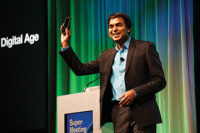Marketing is an important part of owning and operating an HVAC contracting business; however, the budget and strategies widely vary depending on the contractor and size of the company.
Rich Morgan, president of Magic Touch Mechanical Inc. in Mesa, Arizona, said his marketing budget changes slightly each year depending on annual goals. Typically, it comprises about 7-8 percent of the company’s revenue.
“The first thing we do when creating our annual marketing budget is review our revenue goals, project the amount of calls we need for each department to achieve those goals, determine the workload each department can handle, and speculate what our closing rate will be for each product and service per department,” Morgan said. “Once we’ve determined those numbers, we focus on historical, previous year, and current year-to-date analytics to determine what channels, media type, and messages are producing the best results for us and have the best ROI [return on investment].”
Employing creative marketing strategies is important for any type of business, Morgan noted. “How many businesses can you name that remain relevant and successful without doing any marketing? Everyone knows Coca-Cola and McDonalds, but you don’t see those companies resting on that fact. They both market aggressively and consistently and are continually putting out creative new campaigns.
“Our most successful marketing campaigns over the years have been ‘hyper targeted’ to reach a specific group of people,” he continued. “Rather than trying to reach the masses, we spend a lot of time pinpointing exactly the right audience, not even just a specific zip code, but specific households and commercial property owners with a very specific product or service. We will typically use cross-media marketing in order to ‘touch’ that customer several times per campaign. For example, we may target a group of customers that has signed up to receive our newsletters with a specific article in their ‘custom’ newsletter. A week later, we will mail a postcard with a special offer to those customers, and, a week after that, we’ll call those customers and ask if they’ve had a chance to read about that product or service and if they’d like to schedule an appointment to assess their home or equipment. That visit will typically be coupled with a corresponding promotion available only to our VIP clients.”
Steve Moon, owner of Moon Air Inc. in Elkton, Maryland, said his company has increased its marketing budget to 10 percent of gross sales.
“First, you need to decide what is right for your company,” Moon said. “Three to 5 percent of gross sales into your marketing budget means you survive, 5-7 percent means you maintain and have some growth, and 7-10 percent is a schedule for very aggressive growth. Each company has its own place in this world. There are fixed formulas that work, but each owner is maturing at his or her own pace. Some guys only want to operate $250,000 dollar companies, others $1 million, and others $10 million. You choose the type of contracting company you want to become, build the company that suits your needs, decide your budget, and then determine your marketing strategies,” Moon noted.
“There are so many elements to advertising,” he said. “This is why it’s one of the scariest parts of our business. Everyone is an expert and willing to help you spend your budget. I attacked the market from day one by branding myself to my community and working hard to support the community where I live as much as I can. Now, after 30 years of doing this, I could lower my marketing cost considerably and coast, but that is obviously not the route I have chosen for my company or my team.”
LEVERAGING NEW TECHNOLOGIES
Mauzy Heating, Air & Solar in San Diego tries to get into all marketing channels, according to Matt Mauzy, company president.
“Our marketing budget for this year is $1 million,” Mauzy said. “Last year, we spent about $750,000. We determine our budget based on our gross sales and typically do 6 percent of our previous year.
“The way we determine the budget amount depends on the success of the campaign the previous year,” he continued. “For instance, we would take a look at our direct mail campaign from 2016, and we look at our conversion rate to see where that’s at. We also take a look at the dollars generated by that specific campaign and what the conversion percentage was. It gives us a pretty clear picture of where we need to spend our money and how we need to allocate it.”
Additionally, the company tries two new marketing projects each year.
“We try and stay very cutting-edge so that we remain out in front of our competition,” Mauzy said. “We want our competition a year or more behind us when it comes to presentation and technology, as we strive to bring the latest and greatest to our customers. Creative marketing strategies are really important. If you stick with the standard, old-school marketing approach, you’re left behind. Technology moves fast, and customers are reacting just as quickly with cellphones and tablets. If you’re not being creative, you’ll be left behind.”
Last year, Mauzy developed branded virtual reality glasses to leave in customers’ homes after sales calls.
“We have a sales trainer who comes into our business four weeks out of the year,” Mauzy said. “We were talking about cutting-edge technology, and he asked me, ‘In a perfect world, what would I do with my customers?’ And I said, ‘I would love to have half a day to drive them to the office, walk them in the front door, introduce them to everyone, and show them how we do things and how much we care about our customers. Then, I’d put them back in the car and drive them out to some of the jobs we’ve done.’ And he suggested using Google Cardboard virtual reality glasses to do just that.
“You can hold these glasses to your face and have a 360-degree view,” he continued. “Within a week, I found a company that did this and contracted with them to work on the Mauzy virtual reality experience.”
Mauzy said he started out buying 500 custom viewers branded with the Mauzy name.
“This technology works really well when you’re sitting with a customer and one of the decision makers isn’t there. San Diego is an expensive place to live, so, usually, both people work, and it’s tough to get them both there at once. In situations like that, we break out the viewer, have them watch it, and leave it behind. If both people are there, we still break it out and let them view it and have fun with it, and we ask them, ‘Hey, would you like us to leave a pair of these behind for you?’ And about 80 percent of the time, they say, ‘yes.’ They then share it with their neighbors or family members.”
In terms of return on investment, Mauzy said he’s definitely seen a rise in closing percentages since the company started using the virtual reality viewers.
“As a company, we’re closing at about 46 percent,” he said. “Since the VR viewers went into play, we’ve seen about a 3 percent increase. And, frankly, that 3 percent is a decent amount. I don’t have the amount dollar wise, but I would imagine it’s about a 20-22 percent ROI on that 3 percent.”
GOING SOCIAL
With the rise in popularity of Twitter, Facebook, Instagram, and YouTube, some enterprising contractors are employing digital marketing strategies on social media platforms.
Chris Crawford, general manager of Integrity Comfort Solutions in Conroe, Texas, taught himself to use video as a marketing strategy on platforms like Facebook Live and YouTube.
“Everybody is on their phones nowadays,” Crawford said. “If you don’t believe me, drive down the street and look at the people driving next to you — they’re not watching the road, they’re on their phones, which makes me question why people are still putting up billboards, because, obviously, nobody is looking at them. So, we’ve decided to be as digital as possible. Eighty percent of our marketing budget is devoted to digital strategies.”
According to Crawford, search engine optimization (SEO) is still very large, and Facebook is the company’s No. 2 marketing platform.
“Facebook is still the most underrated advertising utility on the planet,” he said. “It’s ridiculously cheap and has so much built into it in the way of analytics. It allows you to target a specific group and advertise directly to them. For instance, we just opened our third location on the west side of Houston. During our first marketing campaign push in that area, we released a video that pinpointed the exact address of the new location. The video only went out to people on Facebook within a 35 mile radius of that location. We were also able to narrow to household income as well as exclude anybody within the HVACR industry. You can really drill down to the exact clients you want to target and advertise only to those people. We started the marketing campaign in the morning, the video was up about four hours, and it had been viewed more than 400 times, just in that demographic I mentioned.”
By focusing most of the budget on Facebook and other digital marketing platforms, Integrity is actually saving about $15,300 per month in its marketing budget.
“The vast majority of HVAC companies out there are not large companies,” Crawford said. “Most are small, family-owned companies that don’t have giant marketing budgets. Proper utilization of social media allows you to get a huge number of people to see your advertising for a very small amount of expenditures. For small companies, that’s a big deal — to have the same exposure as the big guys do and only spend a third of the money.
“In most small mom and pop shops, guess who does the marketing?” he continued. “Usually, it’s the owner or a family member working in the office. And they’ll tell you they didn’t grow up with this type of thing, and they don’t understand it. Well, guess what? Neither did I. But we live in the information age. Honestly, it’s not that hard to get onto YouTube and type in, ‘How do I advertise on Facebook?’ Everybody wants to know how to do it, but nobody wants to spend the time to learn how to do it.”
Crawford also noted that finding the right method will take trial and error. “I think the main thing is if you’re going to do digital advertising, then you need to find the platform that works for you. That’s going to take a lot of trial and error. For some people, video is a great thing. It’s worked out well for us. But, for other people, blog posting may work best. Some people are better writers than they are speakers. My advice is to try different stuff, and don’t be disappointed when you try the first 50 times and fail to gain any traction. It’s not something that happens overnight. You have to play around with it. Somebody may put out two or three videos one month and say, ‘Well, we didn’t really get anything from it,’ and they just stop. That’s not the answer. You have to stick with it and find what works best for you.”
Publication date: 2/20/2017
Want more HVAC industry news and information? Join The NEWS on Facebook, Twitter, and LinkedIn today!











